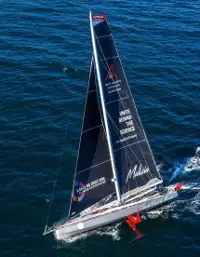|
Teen Climate Activist Sets Sail on Solar-powered Yacht
August 14, 2019
Thunberg, who announced her mode of transport in July, said that she didn't have much sailing in her background but was willing to suffer through whatever seasickness she encountered in order to avoid flying in an airplane because of the carbon emissions generated by such a flight. She has taken a year off school in order to spread her message of climate action and has been traveling around Europe by train. Her journey, aboard the racing yacht Malizia II, is expected to take two weeks. Track Greta's journey here. Pierre Casiraghi, vice-president of the Monaco Yacht Club, and Boris Herrman (in photo above), who has sailed around the world, are the skippers for the journey. The yacht can travel up to 35 knots (40 mph). The skippers said that they would be sailing into the wind for much of the journey so that they would probably not reach the top speed very often. 
The sleek racing yacht has a variety of high-tech equipment, including an ocean lab for measuring levels of carbon dioxide in the water. State-of-the-art solar panels harness the Sun's energy for powering the boat; twin hydro generators use water to power the onboard equipment. The result is a zero-emissions mode of transport. In terms of creature comforts, the yacht, which is designed for racing, is rather spartan. It has four bunks. Thunberg's father, Svante, will be onboard, as will be a documentary filmmaker. The skippers will share the fourth bunk. Because no refrigerator is onboard, food will be a variety of freeze-dried meals. Sanitation is in the form of a plastic bucket that functions as a toilet and a biodegradable bag. 
Thunberg, who is now 16, soared to international recognition in 2018 by going not to school but to Parliament in Stockholm to protest. She had a wooden sign and some flyers, containing facts about carbon footprint and climate change. She spent what would have been her schoolday hours in front of Parliament, holding up the sign and handing out flyers. She went back the next day and found other people ready to stand with her. Every school from then until Sept. 9–the day of her country's general elections–Thunberg spent outside Parliament, holding her own vigil; the crowds with her grew and grew. She wanted to call attention to the fact that her country's environmental policies were not necessarily in line with the 2015 Paris Agreement on actions needed to combat climate change. She is not attending school this year in order to focus fully on her campaign to raise awareness about climate change. She has led the charge for events around the world, including a series of Climatestrike days, in which students and adults in cities on most continents followed Thunberg's example and spent school hours protesting against the pace of climate change. The U.N. summit takes place in New York on September 23. Before that, Thunberg is planning to participate in demonstrations elsewhere in the U.S. Her travel plans after the summit include visits to Canada and to Mexico and then in December to Chile, for the annual U.N. Framework Convention on Climate Change. She has yet to decide how she will travel to those countries or how she will get home. One thing she does know is that she won't be getting on a plane. |
Social Studies for Kids |
Social Studies for Kids
copyright 2002–2024
David White



 It was bon voyage for Greta Thunberg, as the 16-year-old climate activist set sail across the Atlantic, on her way to a United Nations summit on a solar-powered yacht.
It was bon voyage for Greta Thunberg, as the 16-year-old climate activist set sail across the Atlantic, on her way to a United Nations summit on a solar-powered yacht.
